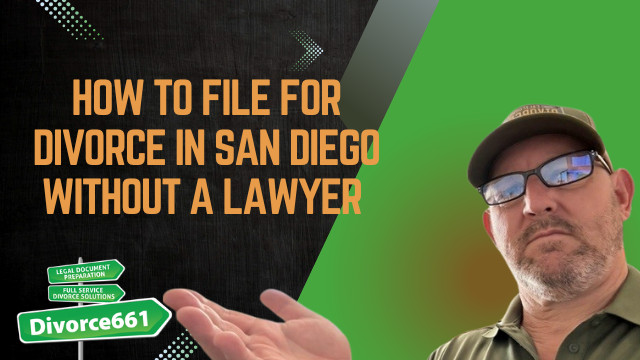How to File for Divorce in San Diego Without a Lawyer | San Diego Divorce
Introduction
Hi, I’m Tim Blankenship with Divorce661. If you’re in San Diego County and considering divorce but want to avoid hiring an attorney, you’re not alone. Many amicable couples choose to handle their divorce without lawyers to save money, reduce stress, and keep the process simple. Below I’ll walk you through exactly how to file for divorce in San Diego without a lawyer, step-by-step, and show you how to avoid the common pitfalls that cause delays or rejections.
Quick checklist: What you need to get started
- Complete initial court forms: Petition (FL-100), Summons (FL-110), and if you have children, Declaration Under the Uniform Child Custody Jurisdiction and Enforcement Act (FL-105/FL-1005 depending on form version).
- File everything electronically using an approved e-filing provider (San Diego requires e-filing).
- Arrange service of the filed papers to your spouse by a third party (not you).
- File proof of service with the court to start the six-month waiting period.
- Exchange complete financial disclosures (Schedule of Assets and Debts, Income and Expense Declaration).
- Draft and sign a Marital Settlement Agreement that meets court standards.
- Submit a complete judgment package to the court for approval.
Step 1 — Prepare and file the initial forms
Start by preparing the required forms. The most common ones are:
- Petition (FL-100) — starts the case and lists basic requests (property, support, custody).
- Summons (FL-110) — tells the other spouse they have been served and explains deadlines.
- Declaration under UCCJEA (FL-105 / FL-1005) — required if you have children, to outline jurisdiction and custody facts.
Important: San Diego County requires electronic filing. Use an approved e-filing provider — do not hand-deliver forms unless specifically instructed by the court. A very common mistake is downloading outdated or incorrect templates; courts will reject incorrect forms immediately.
Step 2 — Serving your spouse
After filing, the papers must be served on your spouse. Key rules:
- You cannot serve the papers yourself. Service must be done by someone 18 or older who is not involved in the case.
- If your spouse is cooperative, they can sign a Notice & Acknowledgement of Receipt to simplify things.
- Once served, file a Proof of Service with the court — this officially starts California’s six-month waiting period before a final judgment can be entered.
Step 3 — Complete financial disclosures
Both parties must exchange full financial disclosures. This includes:
- Schedule of Assets and Debts — a complete list of community and separate property, accounts, retirement, debts, etc.
- Income and Expense Declaration — monthly income, expenses, employment details, and other financial information.
These forms ensure transparency and prevent future claims of concealment. Be thorough: even small omissions or errors can cause the court to reject a judgment or require supplemental disclosures, which delays finalization.
Step 4 — Draft a Marital Settlement Agreement
If you and your spouse agree on the terms, put those agreements into a written Marital Settlement Agreement (MSA). The MSA should address:
- Division of property and debts
- Spousal support (if any)
- Child custody and visitation
- Child support and health insurance
- Enforcement and modification language
Make the language clear, specific, and enforceable. Courts reject vague or incomplete agreements. This is one of the most technical parts of the process and where many self-filers run into problems — the court expects legalistic clarity to ensure the agreement can be entered as a judgment.
Step 5 — Submit the judgment package
Once disclosures are complete and the MSA is signed, assemble your judgment package. This should include:
- All required forms and attachments
- Financial disclosures and supporting documents
- Signed Marital Settlement Agreement
- Any proposed Judgment or Decree forms
If everything is filled out correctly, San Diego courts typically approve judgments within a few weeks. However, if anything is missing or formatted incorrectly, the court may reject the package — sometimes without a clear explanation — which leads to significant delays.
Common pitfalls and how to avoid them
- Using outdated forms: Always download current Judicial Council forms or use a reputable service to prepare them.
- Poorly drafted agreements: Vague or unenforceable provisions are a frequent cause of rejection.
- Incomplete financial disclosures: Omissions or lack of documentation will stall your case.
- Improper service: Serving yourself or using an ineligible server invalidates the process.
- Incorrect e-filing: Filing through the wrong channel or with missing attachments can cause immediate rejection.
“Even a small error or omission can cause the judgment to be rejected.” — Tim Blankenship
How professional help can bridge the gap
Filing without an attorney is possible, but it requires precise paperwork, correct service, complete disclosures, and legally sound agreement language. At Divorce661, we help people file and finalize their divorce without lawyers — but with expert support. We handle forms, disclosures, agreements, and filings so you can avoid court appearances, confusion, and mistakes.
Our services are 100% online, flat-fee, and designed for amicable couples who want a fast, accurate, and court-approved solution in San Diego County.
Conclusion — Next steps
If you’re ready to file for divorce in San Diego without a lawyer but want to feel confident your case is done right, schedule a free consultation at Divorce661.com. We’ll make sure your case is filed correctly, your disclosures are complete, and your judgment package meets the court’s expectations so you can move forward without unnecessary delays.

